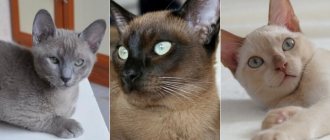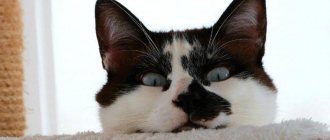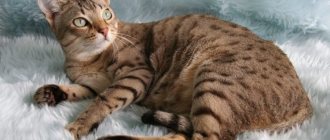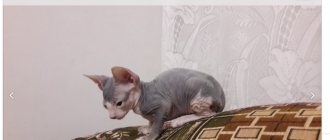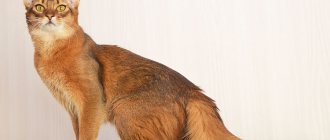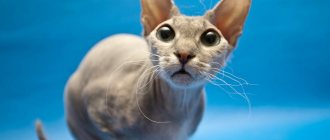Origin story
The homeland of these beauties with slanted eyes and unusually set ears is by no means the island of Java, as it would be logical to assume. In the late 70s of the last century, two American women, Anna Sandner and Maureen Davis, decided on an interesting experiment to breed a breed of cats that looked similar to Orientals, but had a wider range of colors and long hair.
The Siamese, Balinese and Shorthair Oriental genes used in breeding produced a stunning result: a long-haired cat, flexible and graceful like an Oriental Guria, and playful like a child.
The official registration of the new breed occurred in 1979. It was given the name in honor of the island of Java - a subtle hint at the Balinese (the island of Bali is adjacent to Java).
Breeding Javanese
On this path, a potential breeder will face many difficulties, which are associated primarily with the competent selection of individuals. Javanese breeders adhere to three “golden rules”:
- Do not breed only long-haired cats. With the constant crossing of only long-haired individuals, the kittens will be charming and appropriate for the breed, but uncompetitive from the point of view of an exhibition career, which leads to degeneration of the type.
- Regularly breed Javanese dogs with the best representatives of short-haired oriental breeds (Siamese, Orientals, color-point shorthairs). As a result of such matings, Vars are born - cats of an improved type, carriers of the long hair gene (SIA var, OSH var - Siamese Var, Oriental Shorthair Var - this is how they are designated in the pedigree, depending on the ancestor). Subsequently, these cats are crossed either with each other or with Balinese. As a result, the breed replenishes the gene pool and becomes better.
- Remember to preserve beautiful and high-quality “Balinese” wool. Short-haired Siamese and Orientals can have a bad influence on the quality of Javanese wool, so you need to choose short-haired Oriental cats not with ultra-short hair, but with longer hair. Only Javanese and Balinese dogs with the best coat type are selected as partners for them. This is the only way to preserve the distinctive character of the breed.
Removing javanese poses some difficulties
A few other rules:
- you cannot cross two carriers of blue eyes - the offspring will be born dead;
- It is forbidden to cross color-points with non-color-points. To improve non-color-point Javanese, Oriental Shorthair cats of various colors are used;
- cannot be used in breeding individuals with strabismus or carriers of any genetic diseases (corresponding tests to identify “bad” genes are carried out in a veterinary clinic).
When choosing individuals for breeding, it is also worth remembering the various intra-breed types:
- American and European Javanese are standard representatives of the breed;
- English Javanese are more powerful than standard ones. Their coat is much thicker (although the GCCF, the English felinological organization, prescribes the same as the CFA), they are less graceful than their American counterparts. The English type is not found outside the UK. They, like the “Americans,” were formed without the participation of foreign animals, in isolation, which led to such differences.
The Balinese are the progenitors of the American Javanese type.
Russian Javanese are closer to the European type. But their formation within the country was not in vain for them, and now Russian cats often have some disadvantages:
- light frame;
- flat forehead combined with too wide cheekbones;
- the appearance of semi-down and undercoat;
- incorrect size, shape and position of the ears.
You can try to improve the type of Russian Javanese with individuals from Europe and America. But it is much more effective to use Russian Siamese and Orientals, the type of which is close to ideal.
Cats cannot be bred before 1.5 years of age.
Colored Javaneses are not bred with color points.
Some tips for choosing manufacturers:
- remember about blood type compatibility: females of group A mate with males A and B, females of group B with males of group B, males A with females A, males B with females A and B;
- The class of the cat should be show or breed, but it is recommended to take only show cats;
- cats must be absolutely healthy and without genetic defects;
- It is necessary to prepare a package of documents: a pedigree or birth certificate with permission to participate in breeding work, a veterinary passport, if any - exhibition awards, as well as a purchase and sale agreement with the clause that the breeder gives the cat for breeding.
The future Javanese breeder will need:
- Get an education (felinological, veterinary, cat genetics courses).
- Open a nursery. This can only be done by obtaining a diploma of education as a felinologist (by completing a full-time or correspondence course). To open one, you need to contact the club of the breed you are interested in or the representative office of the organization in which it is recognized.
- Buy manufacturers. These can be Balinese, Javanese and Siamese, as well as Javanese and Orientals, depending on what color cats you want to breed: color point or colored.
- Participate with cats in exhibitions to obtain breeding assessments before mating. The cat will need to complete the title, and the cat will need to receive at least two ratings of at least “Very Good.”
- Get a referral for mating from the club where the nursery is registered. To do this, you need to provide pedigrees, titles and divorce assessments of partners.
- Wait until the cat is in heat and isolate them with the cat in a safe room for 2–3 days.
- If the mating is successful, wait 62–69 days until the kittens are born.
- Activate the litter no later than 8 weeks after birth. This is done in the club where the nursery is registered. Upon activation, kittens will be given birth certificates and a breeding certificate. You should come up with names for the kids in advance - they should start with the same letter. Litters are named in alphabetical order in Cyrillic or Latin (the first litter is A, the second, B or C, the third is B or C, etc.). The name of the club is the prefix or “surname” of the kitten.
Description of the breed
The Javan cat appears thin and fragile, although in fact it is a strong animal with muscles of steel, weighing up to 5 kilograms. A long slender body, high limbs with small graceful oval-shaped paws, a flexible tail that can bend in the most bizarre way are the characteristic features of this breed.
The Javanese's head, especially its elongated muzzle, resembles one of the wild relatives of our pets - a puma or a jaguar. Developed cheekbones, a sharp chin and a wide nose without a pronounced bridge of the nose especially contribute to this impression.
The ears of the Javanese are large, tapering upward, set wide apart, sloping to the sides.
The eyes are expressive, slanted, most often emerald green or golden green in color. Animals with white fur may have blue or light blue fur.
The long tail resembles a beautifully feathered feather, wide at the base and smoothly tapering at the tip.
The Javanese's coat is thin, smooth as silk, and completely devoid of undercoat. The belly and tail are more furry than other parts of the body, and the hair on them is longer.
Kitten price
Javanese is a very rare animal in our country. Perhaps it can be found in some Siamese nurseries. The price of a pet-class kitten (as a pet) is from twenty to forty thousand rubles.
For breeding and exhibitions, it is better to purchase a Javanese cat from nurseries in the USA, Canada or the UK. In this case, the cost of the animal will be more than one and a half thousand dollars.
A small photo gallery of Javanese cats:
Character
No less unique than the mysterious appearance is the character of the Javanese women. Most owners of these cats call donkey stubbornness the main feature of their pets. If a Javanese plans to sneak into a locked loggia and lie down in the middle of a flowerpot with violets, he will do it, even if it takes more than one week to implement the plan. If he wants to beg you for a tasty morsel of a dish that is completely unsuitable for him, you will no longer find suffering, pleadingly hungry eyes looking at you with silent reproach!
At the same time, Javanese are extremely playful. If you have a small apartment, it is better to choose a calmer cat instead of a Javanese. To fly up onto a cabinet, jump from it onto the lid of an aquarium, casually walk across the computer keyboard and immediately dive under the sofa - all this takes the oriental beauties seconds.
With other cats, especially those that are alive and as active as himself, the Javanese is on friendly terms. He can play happily with a small dog, but he will lightly tease a large one.
This cat seems like an ideal partner for children, but it is better not to let your child play with the Javanese. The animal may severely scratch or bite the baby if it hurts her.
Temperament and habits
Javanese are very affectionate, they are devoted to their owners and love to follow them. They also love to be held in arms and sleep on the same bed with their owners. They may not be as noisy as Siamese cats, but they are just as persistent. They crave attention and want to be in control.
Javanese pets are very intelligent, agile and physically resilient. Fluffy babies love to fuss, climb trees or scratching posts. A grown-up animal can be taught to go for a walk in a harness, and also perform simple tricks.
A Javanese cat must always have cat toys at his disposal, otherwise he can create a mess in the house. The Javanese are definitely not suitable for people who are phlegmatic and overly scrupulous about order.
The Javanese thrives alone, but thoroughly enjoys time with its owner. To keep your pet from getting bored, you can get another one, but then the house will be a mess.
Care
Despite their exotic appearance, Javanese require the same care as most of their furry relatives.
Twice a week, her silky coat is combed with a fine-toothed comb, after which the cat looks flawless.
Bathe javankas twice a year or as needed, but not too often, using high-quality pet shampoo. After this, the cat is wrapped in a soft, moisture-absorbing towel, the fur is dried with stroking movements and combed.
Javanese large ears require daily inspection and hygiene procedures. They are carefully wiped with a damp cotton pad, and at the slightest sign of discharge, immediately contact a veterinarian.
The eyes are washed every other day with warm water using cotton swabs.
Teeth are brushed two to three times a month.
Nails are regularly trimmed to 1-2 mm.
Javanese cat diseases
Javanese has a number of hereditary diseases that were inherited from her Siamese ancestors. The list of diseases characteristic of such a cat includes strabismus, which occurs quite often, problems with the gastrointestinal tract, asthma, and various heart diseases.
Observation by a veterinarian should be regular. If you suspect any health problem, you should immediately contact a veterinary clinic.
Conclusions about the breed
global $ads_google;
//data-ad-slot=”2475549904″ $ads_google = empty($ads_google) ? false : true; ?> if ($ads_google == false) {?> $ads_google = true; ?> } ?> about the Javanese cat with love; at the exhibition they attract every eye. We can summarize what kind of breed this is:
- External colorful beauty combined with a muscular body creates the image of an oriental cat;
- The nature of cats is suitable for people who prefer active pastime;
- The playfulness of a domestic cat will be appreciated by the owner's children;
- Pets are smart and capable of training;
- Health is not very good, kittens need care and attention;
- Caring for Javanese is not a problem;
- Such cats are very friendly and sociable;
- These are worthy defenders of any home from small rodents.
It is quite possible that a beauty with an oriental look will charm her owner at first sight, and will enter his house with love and devotion.
Nutrition
Active Javanese women, whose lives are in constant motion, require a special diet. It is best to give them premium or super premium food, rich in meat, vitamins and microelements.
If you prefer to feed your pets natural food, be sure to provide B vitamins.
The majority of a Javanese's diet should be lean meat: chicken, turkey, beef or veal.
Teach your cat to eat cottage cheese and kefir, which are indispensable for teeth and bones, and also contribute to better digestion of meat food.
A bowl of javanese must contain a variety of vegetables: boiled pumpkin, zucchini and carrots, fresh cucumber.
Exterior standard
Javankas have small parameters, their mass varies in the range of 2.5-5 kilos. The breed standard is the same for Javanese and Balinese dogs; differences are observed only in color.
Detailed characteristics of the appearance of the Javanese, approved by the association of felinologists CFA:
- The body is not very large, elongated and graceful. A strong physique and well-developed muscles are harmoniously combined.
- The neck is elongated.
- The shoulder girdle and pelvic area complement the graceful contours of the torso. The first should not be narrower than the last.
- The press is toned.
- The limbs are elongated and slender, the forelimbs are shorter.
- The tail is elongated, thin, becoming even thinner at the end. The tail edge resembles a feather.
- The fur is not very long, the longest is on the tail. The fur is thin and silky. There is no undercoat.
- The head is oblong, narrow, wedge-shaped, not very large, in harmony with the body. If you smooth out the fur on the muzzle, the structure of the skull will become obvious. If you look from the side, you can clearly see a straight stripe from the top of the head to the nose, that is, the eyebrows are not bulging and the bridge of the nose is not sunken. The end of the chin is on the same vertical segment with the mirror of the nose.
- The ears are very large, pointed, widened at the base, complementing the wedge-shaped structure of the head.
- The eyes are not very large, resembling almonds, not protruding, but not deep either. Located at an angle to the nose, harmoniously combined with the contours of the head wedge and ears.
- They have bright heavenly colors.
- The nose is elongated and smooth.
Color
The various point colors of the Javanese are its main differences from the Balinese.
So, the fur of a Javanese cat can be the following colors:
- Solid colorpoint colors on a white background. Points can be of different colors, including smoky and silver shades:
- Red-haired with a pink nose;
- Cream with pink nose;
- Cinnamon color with a beige nose;
- Faun with a light pink nose.
- Lynx Point colors come in a variety of colors: from blue to tortie.
- Party color point colors with any color combinations.
Conditions of detention
You should not have a Javanese cat in an apartment, especially in a one-room one. They will be very cramped, and they will definitely turn everything upside down.
The best option is a large private house. There is a lot of space there, the cat will definitely throw out all its energy. A plus would be going out into the yard, where the cat can take a walk and frolic.
The cat must be left with toys, otherwise the cat will play with your things. At best, buy a large play area with stairs and floors. It is a fact that Javanese are sporting cats and they love such areas. You can stock up on intellectual toys.
Walking on a leash is allowed, but it is better to teach this from early childhood so that it does not become a shock for the cat.
For people who do not like noise and disorder, such a cat is definitely not suitable.
Appearance
The appearance of the Javanese is very interesting, and looking at this cat, you want to study its distinctive parts of the face and body.
Javanese weight is 3–5 kg. Height at the withers is 21–25 cm.
| Head | Wedge-shaped and narrow. Resembles an exact triangle. The muzzle is flat, without dents or bulges. |
| Eyes | Almond-shaped, slightly oblique. The color is either blue or green. |
| Ears | Large, wide. They taper towards the tip. |
| Nose | Straight and flat. Long. |
| Body | Medium build, slightly elongated. Sleek and muscular. Some areas are tightened. Cats are a bit skinny. The neck is elongated. |
| Paws | Long, strong and flexible. The hind ones are longer than the front ones. The paws are round. |
| Tail | Long and thin. It's fluffy, even though there's no undercoat there. |
| Wool | Not long, no undercoat. Fine hairs. Fits tightly to the body, silky and soft. |
Thanks to the straightness of their nose, these cats are considered the best in the world.
